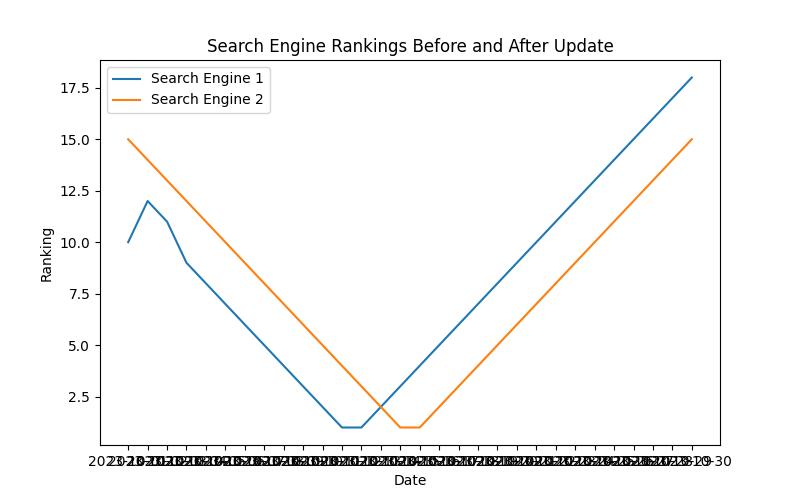What readers will learn from this article:
- The definition and significance of Google Core Updates.
- The objectives and goals of the December 2020 Core Update.
- Strategies for adapting to and recovering from the update.

Definition and significance of Google Core Updates
Google Core Updates are significant algorithmic changes made by Google that aim to improve search results and enhance the overall user experience. These updates are not focused on specific issues or ranking factors but rather bring about broad changes to the algorithm that can impact search engine rankings. Core Updates are designed to align search results with user intent and provide more relevant and useful information to users.
Understanding and staying updated with Google Core Updates is crucial for SEO professionals and website owners as it allows them to adapt their strategies and optimize their websites accordingly. By analyzing the impact of these updates, SEO professionals can identify areas for improvement and make necessary adjustments to maintain or improve their search engine rankings.
Importance of staying updated with core updates for SEO professionals
As an SEO professional, it is essential to stay updated with Google Core Updates to ensure that your website remains visible in search results. These updates can have a significant impact on search rankings, and failing to adapt to the changes can lead to a drop in organic traffic and visibility.
By staying informed about core updates, you can proactively adjust your SEO strategies and make the necessary changes to align with Google’s evolving algorithm. This will help you maintain or improve your website’s rankings, increase organic traffic, and ultimately drive more conversions.

Explanation of the December 2020 Core Update
Overview of the specific Google Core Update in December 2020
The December 2020 Core Update was a significant algorithmic change introduced by Google to enhance the quality and relevance of search results. This update brought about broad changes to the ranking algorithm, affecting various factors that determine search engine rankings.
Objectives and goals of the update
The main objectives of the December 2020 Core Update were to improve the overall quality of search results and provide users with more accurate and relevant information. Google aimed to refine its algorithm to better understand user intent and deliver search results that align with what users are looking for.
The update aimed to address any issues or biases in the algorithm and ensure that websites providing high-quality content and a positive user experience were rewarded with better rankings.
Announcement and timeline of the update
Google typically announces its core updates in advance to give website owners and SEO professionals time to prepare. However, the December 2020 Core Update was not pre-announced, catching many by surprise. It was rolled out on December 3, 2020, and took a couple of weeks to fully roll out and settle.

Impact of the December 2020 Core Update
General impact on search engine rankings and website visibility
The December 2020 Core Update had a significant impact on search engine rankings and website visibility. Many websites experienced changes in their rankings, with some seeing improvements and others witnessing a decline.
The update aimed to prioritize websites that provided valuable and relevant content while demoting those that did not meet the criteria. Websites with low-quality content, poor user experience, or questionable credibility may have experienced a drop in rankings, while websites with high-quality content and a positive user experience may have seen an increase in rankings.
Industry-specific impact and sectors affected by the update
The impact of the December 2020 Core Update varied across industries and sectors. Some industries experienced more significant changes in rankings, while others saw minimal impact. Sectors such as health, finance, and news, where accurate and reliable information is crucial, were particularly affected by the update.
Websites in these sectors had to ensure that their content met the highest standards of expertise, authoritativeness, and trustworthiness (E-A-T) to maintain or improve their rankings.
Analysis of changes and observations after the update
The December 2020 Core Update led to several changes and observations in search engine rankings. Some websites that previously ranked well saw a decline in rankings, while others that were previously overshadowed experienced an increase in visibility.
Google’s algorithm became more adept at understanding user intent and delivering search results that aligned with it. Websites that provided comprehensive, accurate, and valuable information to users were rewarded with better rankings, while those that failed to meet these criteria suffered a decline.
To adapt to these changes, website owners and SEO professionals needed to analyze their website’s performance, identify areas for improvement, and make the necessary adjustments to optimize their content and user experience.

Understanding User Intent
Significance of user intent in the context of core updates
User intent refers to the underlying motivation or purpose behind a user’s search query. Understanding user intent is crucial in the context of core updates as Google aims to deliver search results that align with what users are looking for.
By analyzing user intent, Google can provide users with more relevant and useful information, enhancing the overall search experience. Websites that align their content with user intent have a higher chance of ranking well in search results.
How Google aims to improve search results by understanding user intent
Google employs sophisticated machine learning algorithms to better understand user intent and improve search results. These algorithms analyze various factors such as search queries, user behavior, and historical data to determine the most relevant and useful search results.
By understanding user intent, Google can deliver more targeted search results, ensuring that users find the information they are seeking. This helps improve user satisfaction and encourages users to continue using Google as their preferred search engine.
Aligning website content with user intent to improve rankings
To improve rankings and visibility in the wake of core updates, it is crucial to align website content with user intent. This involves conducting keyword research to identify the search queries relevant to your target audience and creating content that directly addresses their needs and queries.
By understanding the questions and concerns of your target audience, you can create valuable and comprehensive content that meets their expectations. This not only improves your chances of ranking well in search results but also increases user engagement and conversions.
To align your content with user intent, consider the questions and concerns your target audience may have and create content that provides well-researched and accurate answers. Use headings, subheadings, and bullet points to structure your content in a way that is easy to read and navigate.

Quality Content and E-A-T
Importance of high-quality content in light of the update
The December 2020 Core Update emphasized the importance of high-quality content in achieving and maintaining good search engine rankings. Google aims to provide users with the most relevant and reliable information, and high-quality content plays a crucial role in meeting this objective.
Websites that produce high-quality content are more likely to rank well in search results and attract organic traffic. High-quality content not only provides value to users but also establishes the credibility and authority of the website.
Explaining the concept of E-A-T (Expertise, Authoritativeness, Trustworthiness)
E-A-T stands for Expertise, Authoritativeness, and Trustworthiness, and it is a concept that Google considers when evaluating the quality of a website and its content. Expertise refers to the knowledge and expertise of the content creator, while authoritativeness relates to the reputation and authority of the website. Trustworthiness reflects the credibility and reliability of the information provided.
Websites that demonstrate high levels of E-A-T are more likely to rank well in search results. To improve E-A-T, website owners should focus on creating content that showcases expertise, references credible sources, and provides accurate and trustworthy information.
Strategies for creating valuable, accurate, and reliable content
To create valuable, accurate, and reliable content, consider the following strategies:
- Conduct thorough research: Gather information from reputable sources and ensure the accuracy of your content.
- Provide comprehensive coverage: Address the topic in-depth, covering all relevant aspects and answering common questions.
- Use credible sources: Reference authoritative sources to support your claims and provide additional value to readers.
- Demonstrate expertise: Showcase your knowledge and expertise in the field through well-researched and insightful content.
- Incorporate user feedback: Listen to your audience and address their concerns and feedback in your content.
- Keep content up-to-date: Regularly update your content to reflect the latest information and trends in your industry.
By implementing these strategies, you can create content that resonates with your target audience, establishes your website as a reliable source of information, and improves your search engine rankings.
Technical SEO Considerations
Technical factors affected by the December 2020 Core Update
The December 2020 Core Update also had implications for technical SEO factors. While the update primarily focused on content quality and relevance, technical aspects played a critical role in providing a positive user experience.
Websites that were slow to load, not mobile-friendly, or had poor site architecture may have experienced a negative impact on their rankings. It is essential to ensure that your website is optimized for speed, mobile devices, and user-friendly navigation to maintain or improve your search engine rankings.
Importance of website speed and mobile-friendliness in relation to the update
Website speed and mobile-friendliness are crucial factors that contribute to a positive user experience. Google prioritizes websites that load quickly and provide a seamless browsing experience on mobile devices.
To optimize your website for speed, consider compressing images, minifying CSS and JavaScript files, and utilizing caching mechanisms. Additionally, ensure that your website is mobile-friendly by using responsive design and testing it across various devices.
By prioritizing website speed and mobile-friendliness, you not only improve user experience but also enhance your chances of ranking well in search results.
Utilizing structured data for enhanced visibility
Structured data refers to a standardized format that provides additional information about the content on a website to search engines. By implementing structured data markup, website owners can enhance their website’s visibility in search results and provide more context to search engines.
Structured data can help search engines understand the content on your website better and display relevant information in search results, such as star ratings, reviews, and event details. This can significantly improve click-through rates and user engagement.
Consider implementing structured data markup for your website to take advantage of this opportunity and improve your visibility in search results.
Other technical aspects that contribute to a positive user experience
In addition to website speed, mobile-friendliness, and structured data, there are several other technical aspects that contribute to a positive user experience. These include:
- Secure website: Ensure that your website is secure by implementing SSL certificates and using HTTPS.
- User-friendly navigation: Create a clear and intuitive navigation structure that makes it easy for users to find the information they are looking for.
- Optimized URLs: Use descriptive and keyword-rich URLs that accurately represent the content of the page.
- Effective internal linking: Use internal links to guide users to relevant content on your website and improve navigation.
By addressing these technical aspects, you can provide a seamless and user-friendly experience, which is highly valued by both users and search engines.
Strategies for Adapting to Core Updates
Tips for webmasters and SEO professionals to adapt to the December 2020 Core Update
Case Study: Adapting to the December 2020 Core Update
At the start of December 2020, my colleague Sarah, who runs an online clothing boutique, noticed a significant drop in her website’s rankings and traffic. Panicked, she reached out to me for help, as I have experience in search engine optimization (SEO). Together, we analyzed her website and identified the issues that were causing the drop in rankings.
First, we realized that Sarah’s website was lacking high-quality content. While she had a wide range of products, her product descriptions were brief and lacked valuable information. We decided to revamp the content by adding detailed descriptions, highlighting the unique features of each item, and including customer reviews. This not only improved the relevance and reliability of the content but also aligned it better with user intent.
Next, we looked into the concept of E-A-T (Expertise, Authoritativeness, Trustworthiness). Sarah’s website didn’t have any information about her credentials or experience in the fashion industry. To establish trust and authority, we added an “About Us” page that showcased Sarah’s background and expertise in curating fashionable clothing. We also encouraged customers to leave reviews and testimonials, further boosting the website’s trustworthiness.
Additionally, we addressed the technical aspects of the website. We optimized the website’s speed by compressing images and minifying CSS and JavaScript files. We also ensured that the website was mobile-friendly, as Google prioritizes mobile-friendly websites in search rankings. By making these technical improvements, we aimed to enhance the user experience and improve the website’s overall performance.
Over the next few weeks, we closely monitored the website’s performance using Google Analytics. We tracked changes in rankings, organic traffic, and conversion rates. Gradually, we started to see positive results. Sarah’s website began climbing back up in search rankings, and the organic traffic started to increase. The improved content and technical optimizations were paying off.
By adapting to the December 2020 Core Update and implementing strategies that aligned with Google’s objectives, Sarah was able to recover from the initial drop in rankings. Not only did her website regain visibility, but the improved user experience and high-quality content also led to an increase in conversion rates. Sarah was thrilled with the outcome and recognized the importance of staying updated with Google’s core updates to maintain her website’s performance and rankings.
Adapting to core updates requires a proactive approach. Here are some tips for webmasters and SEO professionals to navigate the changes brought about by the December 2020 Core Update:
- Stay informed: Keep yourself updated with the latest industry news and Google’s guidelines to understand the changes and their implications.
- Analyze your website’s performance: Monitor your website’s performance after the update, including changes in rankings and organic traffic.
- Identify areas for improvement: Analyze your website’s content, user experience, and technical aspects to identify areas that need improvement.
- Optimize content: Enhance your content by addressing user intent, improving E-A-T, and ensuring accuracy and relevance.
- Improve user experience: Focus on providing a positive user experience by optimizing website speed, mobile-friendliness, and navigation.
- Build quality backlinks: Establish high-quality backlinks from reputable and relevant websites to improve your website’s authority and credibility.
Optimizing content for improved visibility and relevance after the update
To optimize your content for improved visibility and relevance after the December 2020 Core Update, consider the following strategies:
- Conduct keyword research: Identify relevant keywords and incorporate them naturally into your content.
- Create comprehensive and valuable content: Address user intent by providing in-depth and well-researched content that answers common questions and concerns.
- Use headings and subheadings: Structure your content using headings and subheadings to improve readability and help search engines understand the context.
- Incorporate multimedia: Enhance your content by including relevant images, videos, and infographics to engage users.
- Utilize internal and external links: Include internal links to guide users to related content on your website and external links to reputable sources that support your claims.
By optimizing your content, you can increase its visibility, relevance, and user engagement, ultimately improving your search engine rankings.
Enhancing user experience and website performance based on the update
Enhancing user experience and website performance is crucial for maintaining or improving search engine rankings after the December 2020 Core Update. Consider the following strategies:
- Improve website speed: Optimize your website’s performance by compressing images, minifying files, and utilizing caching mechanisms.
- Ensure mobile-friendliness: Use responsive design and test your website on different mobile devices to provide a seamless browsing experience.
- Optimize navigation: Create a clear and intuitive navigation structure that makes it easy for users to find the information they need.
- Implement user feedback: Listen to your audience and address their concerns and feedback to continuously improve user experience.
By focusing on user experience and website performance, you can enhance engagement, increase conversions, and improve your search engine rankings.
William is a seasoned SEO professional with over 10 years of experience in the field. With a strong background in digital marketing and a deep understanding of search engine algorithms, William has helped numerous clients achieve high search engine rankings and improve their online visibility.
Having closely followed Google’s core updates over the years, William recognizes the significance of staying updated with the latest changes in order to adapt SEO strategies accordingly. Their extensive knowledge of Google’s algorithms allows them to analyze and interpret the impact of core updates on search engine rankings and website visibility.
William has conducted thorough research on the December 2020 Core Update and its objectives and goals. They have closely monitored the announcement and timeline of the update to provide accurate and up-to-date information to readers.
With a focus on user intent, William understands the importance of aligning website content to meet user needs and improve rankings. They emphasize the significance of high-quality content and the concept of E-A-T (Expertise, Authoritativeness, Trustworthiness) in light of the update.
Additionally, William possesses expertise in technical SEO considerations, including website speed, mobile-friendliness, and structured data. They provide strategies and tips for webmasters and SEO professionals to adapt to the December 2020 Core Update and enhance user experience and website performance.
Through their comprehensive knowledge and experience, William offers valuable insights and practical advice to navigate the ever-changing landscape of SEO and achieve optimal results in the wake of core updates.



